Norway Facility Management Market Size
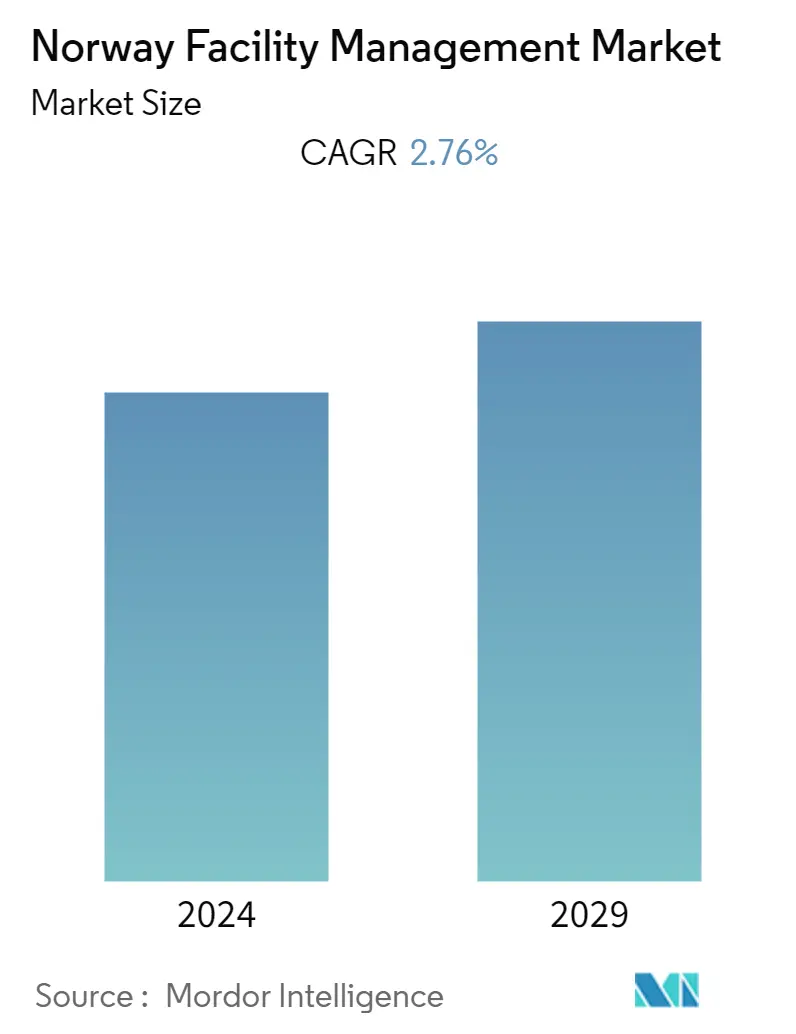
| Study Period | 2019 - 2029 |
| Base Year For Estimation | 2023 |
| Forecast Data Period | 2024 - 2029 |
| Historical Data Period | 2019 - 2022 |
| CAGR | 2.76 % |
| Market Concentration | Medium |
Major Players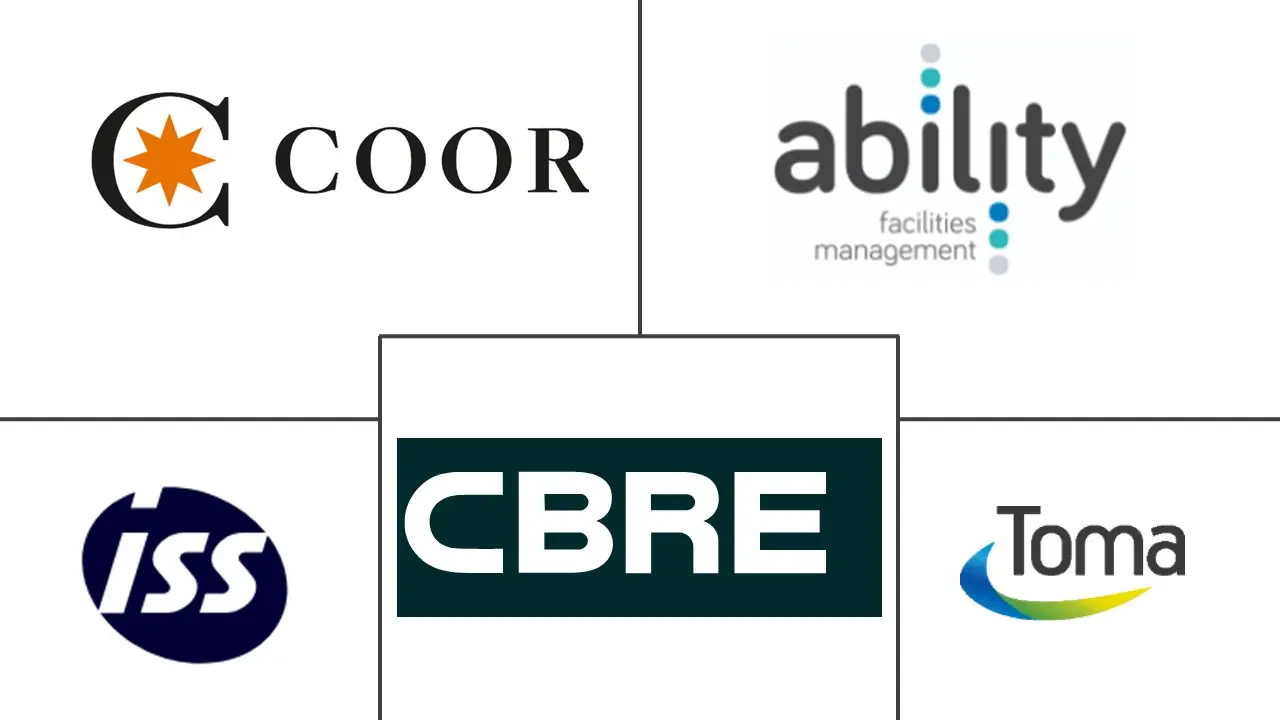
*Disclaimer: Major Players sorted in no particular order |
Norway Facility Management Market Analysis
The Norway Facility Management Market was valued at USD 9.0 billion the previous year and is expected to register a CAGR of 2.76%, reaching USD 10.53 billion by the next five years. Facility management consists of multiple factors that influence the productivity and efficiency of organizations. The new management system standard, conforming with the industry practices, constitutes a benchmark for developing and driving effective strategic, tactical, and operational FM principles across Norway.
- Facility management (FM) includes management methods and techniques for building management, infrastructure management for an organization, and overall harmonization of the work environment in an organization. This system standardizes services and streamlines processes for an organization.
- Tech innovations in facility management are expected to drive significant growth in the Norway market by improving efficiency, reducing costs, enhancing user experiencing, and aligning with the country's focus on sustainability. As technology continues to evolve, innovations will likely emerge, further shaping the facility management landscape in Norway.
- As the workplace environment evolves, facility management will remain critical for businesses in Norway to enhance productivity, employee satisfaction, and operational effectiveness. By adapting to changing needs of organizations and leveraging innovative technologies, the facility management market in Norway is likely to experience sustained growth driven by this renewed emphasis on workplace optimization and productivity.
- Diminishing profit margins and ongoing macro-environment changes restrain the country's market growth. While sustainability was gaining importance in the facility management market, a decreased emphasis on environmental issues may have impacted workplace optimization efforts.
- With the implementation of lockdowns and social distancing measures during the COVID-19 pandemic, many businesses in Norway transitioned to remote work or adopted flexible work arrangements. This shift reduced the immediate demand for on-site facility management services, as fewer employees were in physical workplaces.
- The COVID-19 pandemic accelerated the adoption of technology in facility management. Post-COVID-19, facility managers are likely to continue leveraging digital solutions for remote monitoring, contactless operations, and data analytics to enhance efficiency and reduce physical interactions.
Norway Facility Management Market Trends
In-house Facility Management Offering Type Holds Significant Market Share
- In-house facility management refers to services provided by a dedicated resource directly employed by the client organization. In this type of facility management, monitoring and control of the performance is usually conducted under the terms of a conventional employee/employer relationship.
- In-house facility management involves recruiting specialized personnel to maintain and manage various functional attributes of a facility or area. These days, most generic services are outsourced to third-party service providers. However, some services, such as security services or cybersecurity assistance, are still operated and monitored in-house to ensure the safety and integrity of the facilities.
- Organizations manage their buildings' maintenance and repair, including electrical systems, plumbing, HVAC, and other infrastructure. The in-house staff cleans and maintains the workplace, ensuring cleanliness, hygiene, and tidiness.
- Factors including increased consumer spending, economic activity, and tourism activities have augmented the occupancy of large residential layouts/projects, hotels, and commercial spaces. This has, in turn, increased the need for better management of the facilities.
- The country is witnessing increasing construction in the residential sector, which would further boost the demand for in-house facility management services. According to Statistics Norway, the number of residential buildings in Norway built from 2021 to April 2023 amounted to almost 60,000 units. In the decade between 2011 and 2020, approximately 296,000 residential buildings were built in Norway.
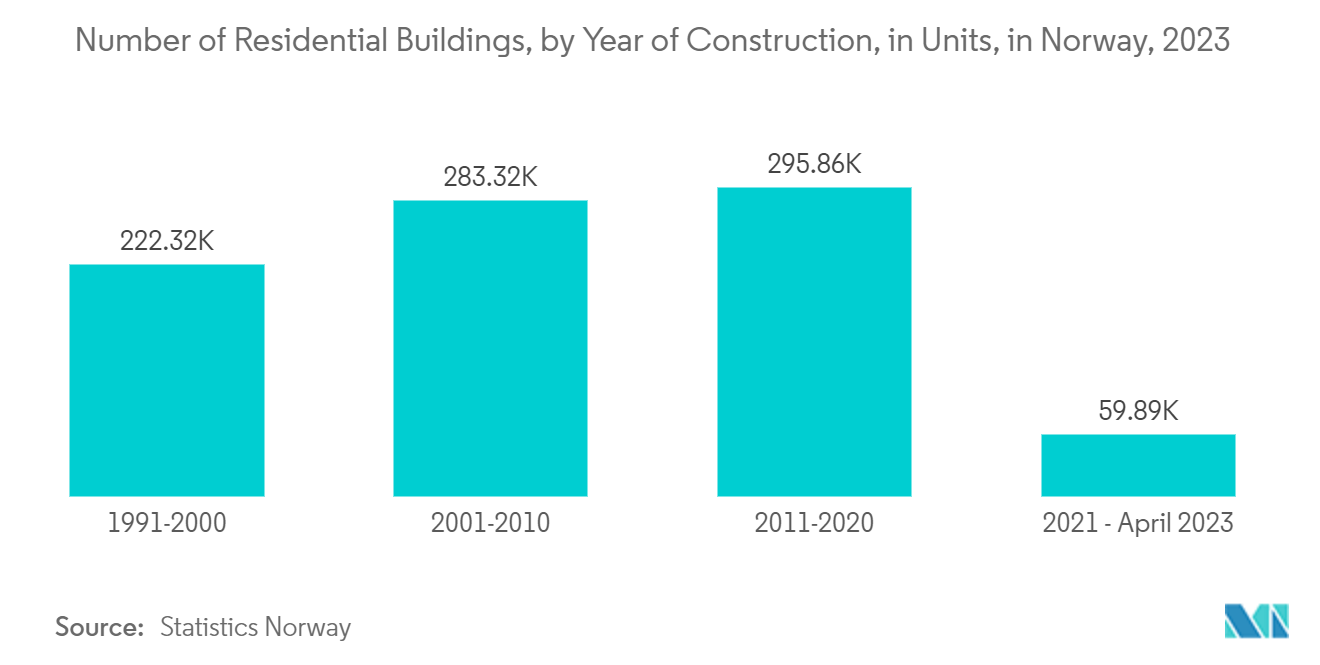
Commercial and Retail End-User Holds Significant Market Share
- The commercial end-user sector mostly refers to office buildings used by suppliers of business services, such as manufacturers' corporate offices, IT and communication businesses, and other service providers.
- Retail facilities management refers to making a company's location hygienic, secure, and welcoming while boosting the brand and simplifying things for the clients. Cleaning floors, restrooms, and window displays, assembling eye-catching retail displays, and occasionally completely renovating the facility or shop floor constitute the retail facilities management process. These tasks vary based on the requirements of the client.
- Also, the market provides several chances for manufacturers to adopt and execute different IoT-based facility management and smart building development across the country. This is due to the increased interest in constructing smart buildings and IoT technology. Furthermore, the increase in business acumen among industry suppliers and the expansion of the economy from diverse industries is expected to boost demand for facility management services in the country.
- Increasing non-residential building construction and development drive the demand for facility management (FM) services in the commercial and retail sectors of the Norway FM market. As the number of retail properties grows, there is a corresponding need for comprehensive facility management to ensure these buildings' efficient operation, maintenance, and optimization.
- According to Statistics Norway, the number of existing non-residential buildings in Norway increased constantly between 2010 and 2023. In 2023, there were over 2.7 million non-residential buildings existing in Norway.
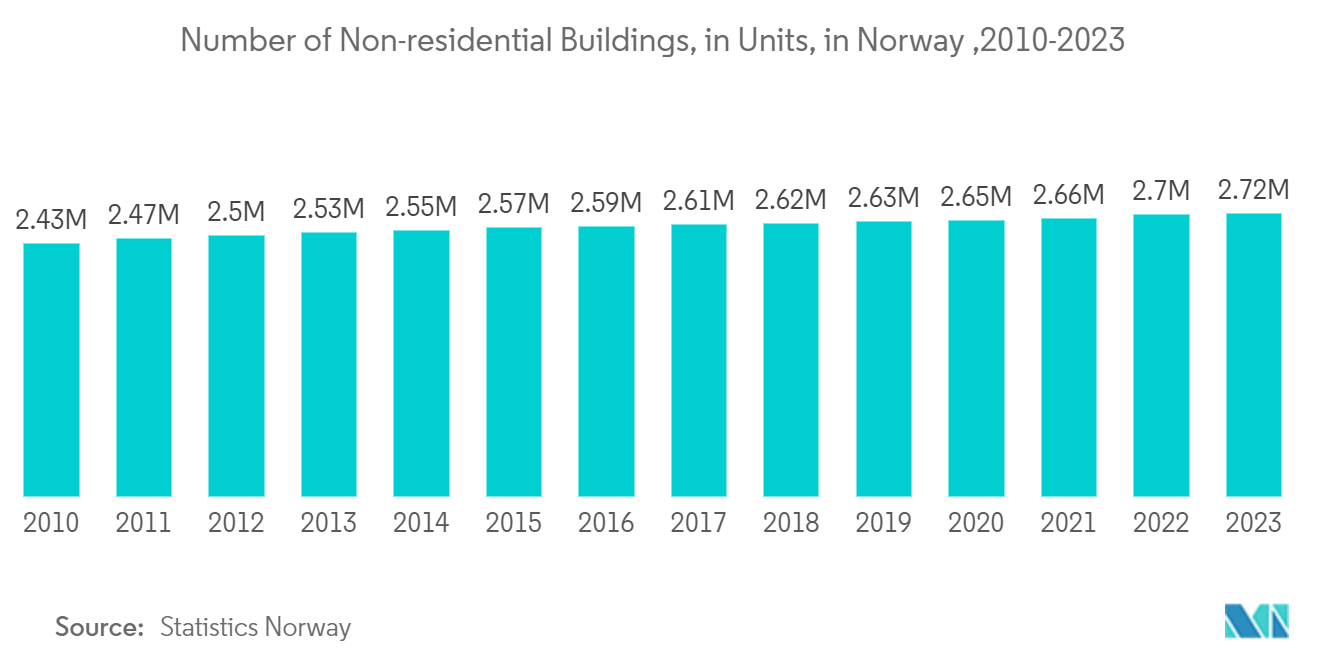
Norway Facility Management Industry Overview
The Norway facility management market is moderately fragmented, with major players like ISS Facility Services, Toma Facility Services AS, Coor Service Management, CBRE Group, and Ability FM. Players in the market are adopting strategies such as partnerships and acquisitions to enhance their product offerings and gain sustainable competitive advantage. In
In June 2023, CBRE Acquired work-in-progress (WiP) to Enhance Workplace and Change Management Services across Continental Europe. WiP provides strategic consultancy focused on helping occupiers to optimize workplace experience and employee engagement.
Norway Facility Management Market Leaders
-
ISS Facility Services
-
Toma Facility Services AS
-
Coor Service Management
-
CBRE Group
-
Ability FM
*Disclaimer: Major Players sorted in no particular order
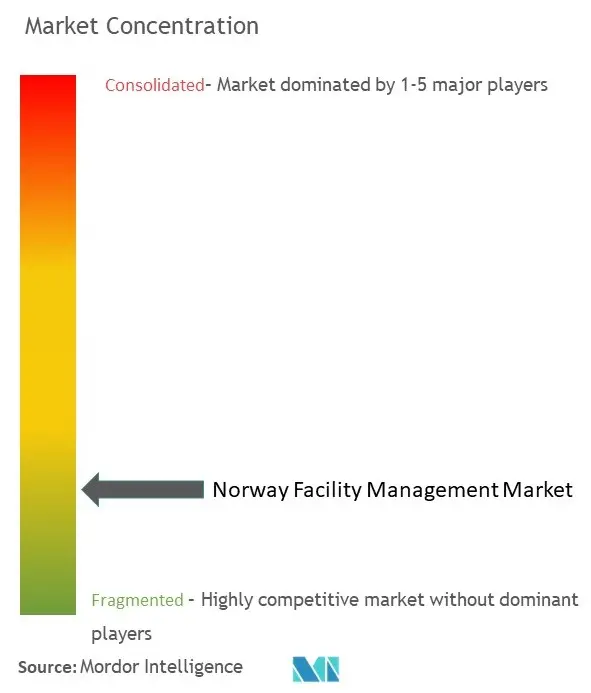
Norway Facility Management Market News
- July 2023: Bravida expands their agreement within technical Facility Management with Schneider Electric to install charging points and provide the Bravida Charge service. This is for Schneider Electric's premises in Sweden, Norway, and Denmark.
- April 2023: Verso Capital acquired the Facility Management business from Office Management, one of the leading IT and Office services providers in the Nordics. The acquired Facility Management business will focus on serving existing and new customers with a one-stop shop for a wide range of services to simplify daily life and improve efficiency in office environments.
Norway Facility Management Market Report - Table of Contents
1. INTRODUCTION
- 1.1 Study Assumptions and Market Definition
- 1.2 Scope of the Study
2. RESEARCH METHODOLOGY
3. EXECUTIVE SUMMARY
4. MARKET INSIGHTS
- 4.1 Market Overview
-
4.2 Industry Attractiveness - Porter's Five Forces Analysis
- 4.2.1 Bargaining Power Of Suppliers
- 4.2.2 Bargaining Power Of Buyers
- 4.2.3 Threat Of New Entrants
- 4.2.4 Threat Of Substitutes
- 4.2.5 Intensity Of Competitive Rivalry
- 4.3 Impact of COVID-19 On the Industry
5. MARKET DYNAMICS
-
5.1 Market Drivers
- 5.1.1 Tech innovations in Facilities Management is Expected to Witness Significant Growth
- 5.1.2 Renewed Emphasis on Workplace Optimization and Productivity
-
5.2 Market Restraints
- 5.2.1 Diminishing Profit Margins and Ongoing Changes in Macro-environment
- 5.3 Analysis of Prevalent Standard Practices, Service Agreements, Contracts, and Pricing Models
- 5.4 Analysis of the IFM Service Contracts Undertaken in the Country
6. MARKET SEGMENTATION
-
6.1 By Offering Type
- 6.1.1 In-house Facility Management
- 6.1.2 Outsourced Facility Management
-
6.2 By Service Type
- 6.2.1 Hard FM
- 6.2.2 Soft FM
-
6.3 By End-User
- 6.3.1 Commercial and Retail
- 6.3.2 Institutional
- 6.3.3 Infrastructure and Public Entities
- 6.3.4 Industrial and Manufacturing
- 6.3.5 Other End-Users
7. KEY VENDOR PROFILES
-
7.1 Company Profiles
- 7.1.1 ISS Facility Services
- 7.1.2 Toma Facility Services AS
- 7.1.3 Coor Service Management
- 7.1.4 CBRE Group
- 7.1.5 Ability FM
- 7.1.6 Sodexo
- 7.1.7 Compass Group
- 7.1.8 Contractia Oy
- *List Not Exhaustive
8. RANKING ANALYSIS OF KEY VENDORS
9. MARKET OPPORTUNITIES AND FUTURE TRENDS
** Subject To AvailablityNorway Facility Management Industry Segmentation
Facility management (FM) services involve building upkeep, utilities, maintenance operations, waste services, security, etc. Hard facility management services and soft facility management services further segment these services. The adoption of FM solutions and services is likely to be driven by several factors, including an increase in demand for cloud-based FM solutions and a rise in demand for FM systems linked to intelligent software.
The Norway Facility Management market is Segmented by Offering Type (In-house Facility Management, Outsourced Facility Management), Service Type (Hard Facility Management. Soft Facility Management), and End-User (Commercial and Retail, Institutional, Infrastructure and Public Entities, Industrial and Manufacturing). The market sizes and forecasts are provided in terms of value in USD for all the above segments.
| By Offering Type | In-house Facility Management |
| Outsourced Facility Management | |
| By Service Type | Hard FM |
| Soft FM | |
| By End-User | Commercial and Retail |
| Institutional | |
| Infrastructure and Public Entities | |
| Industrial and Manufacturing | |
| Other End-Users |
Norway Facility Management Market Research FAQs
What is the current Norway Facility Management Market size?
The Norway Facility Management Market is projected to register a CAGR of 2.76% during the forecast period (2024-2029)
Who are the key players in Norway Facility Management Market?
ISS Facility Services, Toma Facility Services AS, Coor Service Management, CBRE Group and Ability FM are the major companies operating in the Norway Facility Management Market.
What years does this Norway Facility Management Market cover?
The report covers the Norway Facility Management Market historical market size for years: 2019, 2020, 2021, 2022 and 2023. The report also forecasts the Norway Facility Management Market size for years: 2024, 2025, 2026, 2027, 2028 and 2029.
Norway Facility Management Industry Report
Statistics for the 2024 Norway Facility Management market share, size and revenue growth rate, created by Mordor Intelligence™ Industry Reports. Norway Facility Management analysis includes a market forecast outlook to for 2024 to 2029 and historical overview. Get a sample of this industry analysis as a free report PDF download.



